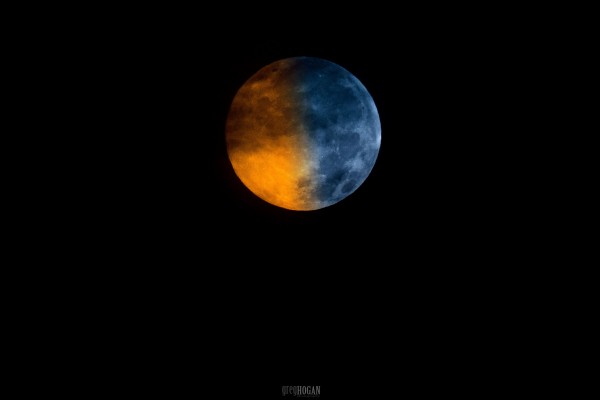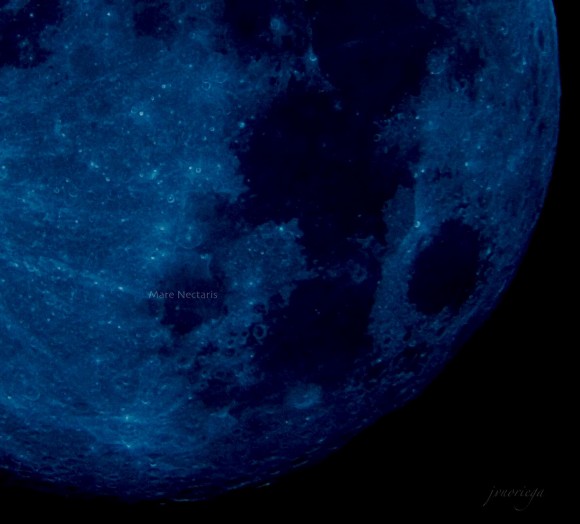

Most Blue Moons are not blue in color. This photo of a moon among fast-moving clouds was created using special blue filters. Image via our friend Jv Noriega.
The first full moon of this month fell on October 1-2, 2020. It was the Northern Hemisphere’s Harvest Moon, or full moon nearest the September equinox. This month will have a second full moon, which – by popular decree – shall be called a Blue Moon. It’ll come on October 31, 2020, which is the night of Halloween. The moon will be blue in name only, but it’ll be near in the sky to a bright red “star” – not really a star at all – but the fiery planet Mars, still at its best now! Don’t miss them.
Read more: Blue Moon and red Mars on Halloween
The last Blue Moon by this definition – the last time we had a second full moon in a single calendar month – was March 31, 2018.
There’s another definition for Blue Moon. It can also be the third of four full moons in a single season, with a season being between a solstice and equinox. The next seasonal Blue Moon will be August 22, 2021.
In recent years, people have been using the name Blue Moon for these two different sorts of moons: second of two full moons in a calendar month, or third of four full moons in a single season.
Blue-colored moons in photos – like the ones on this page – are usually made using special blue camera filters or in a post-processing program such as PhotoShop.
Someday, you might see a true blue-colored moon in the sky. Blue-colored moons are rare – aren’t necessarily full – and happen when Earth’s atmosphere contains dust or smoke particles of a certain size, slightly wider than 900 nanometers. Particles of this size are very efficient at scattering red light. When these particles are present in our air, and the moon shines through them, the moon may appear blue in color. For more about truly blue-colored moons, click here.
Meanwhile, the full moon you’ll see on October 31, 2020, likely won’t look blue. But – as the second full moon in a month – many will call it a Blue Moon. The bright red object nearby will be Mars.

The very bright red object near the moon on October 30 and 31 is the planet Mars, still at its best for this 2-year period. Earth passed between Mars and the sun on October 13. Read more: Blue Moon and red Mars on Halloween
Let’s talk about seasonal Blue Moons first. It’s an older definition for Blue Moons, stemming from old skylore. A year has 12 months, of course. A month – or “moonth” – has a length more or less based on a single orbit of the moon around Earth. What we call a season – winter, spring, summer, fall – typically lasts three months, and typically has three full moons.
If a season has four full moons, then the third full moon may be called a Blue Moon, according to the old Maine Farmer’s Almanac. There was a Blue Moon by this definition on November 21, 2010, another on August 20-21, 2013, another on May 21, 2016, and another on May 18, 2019.
The next will be on August 22, 2021.
In modern times, most of us know Blue Moons as the second full moon of a calendar month. By this definition, there was a Blue Moon on July 31, 2015; January 31, 2018; and March 31, 2018. The next one will be October 31, 2020.
The time between one full moon and the next is close to the length of a calendar month. So the only time one month can have two full moons is when the first full moon happens in the first few days of the month. This happens every two to three years, so these sorts of Blue Moons come about that often.
Very rarely, a seasonal Blue Moon (third of four full moons in one season) and a monthly Blue Moon (second of two full moons in one calendar month) can occur in the same calendar year. For this to happen, you need 13 full moons between successive December solstices for a seasonal Blue Moon – and, generally, 13 full moons in one calendar year for a monthly Blue Moon.
This will next happen in the year 2048, when a monthly Blue Moon falls on January 31, and a seasonal Blue Moon on August 23.
Then 19 years later, in the year 2067, there will be a monthly Blue Moon on March 30, and a seasonal Blue Moon on November 20. In this instance, there are 13 full moons between successive December solstices – but only 12 full moons in one calendar year and no February 2067 full moon.

Blue moons don’t really look blue in color. Greg Hogan got this shot of a Blue Moon (blue in name only!) on July 31, 2015. He wrote: “Having some fun with the blue moon idea … I blended the same image twice one with a blue tint, and one normal. 🙂 “
The idea of a Blue Moon as the second full moon in a month stemmed from the March 1946 issue of Sky and Telescope magazine, which contained an article called Once in a Blue Moon by James Hugh Pruett. Pruett was referring to the 1937 Maine Farmer’s Almanac, but he inadvertently simplified the definition. He wrote:
Seven times in 19 years there were – and still are – 13 full moons in a year. This gives 11 months with one full moon each and one with two. This second in a month, so I interpret it, was called Blue Moon.
Had James Hugh Pruett looked at the actual date of the 1937 Blue Moon, he would have found that it had occurred August 21, 1937. Also, there were only 12 full moons in 1937. You generally need 13 full moons in one calendar year to have two full moons in one calendar month.
However, that fortuitous oversight gave birth to a new and perfectly understandable definition for Blue Moon.
In the late 1970s, EarthSky’s Deborah Byrd happened upon a copy of this old 1946 issue of Sky and Telescope in the stacks of the Peridier Library at the University of Texas Astronomy Department. Afterward, she began using the term Blue Moon to describe the second full moon in a calendar month on the radio series Star Date, which she wrote and produced. Later, this definition of Blue Moon was also popularized by a book for children by Margot McLoon-Basta and Alice Siegel, called Kids’ World Almanac of Records and Facts, published in New York by World Almanac Publications in 1985. The second-full-moon-in-a-month definition was also used in the board game Trivial Pursuit.
Today, it has become part of modern folklore. As the folklorist Philip Hiscock wrote in his comprehensive article Once in a Blue Moon:
‘Old folklore’ it is not, but real folklore it is.

It’s very rare that you would see a moon that’s actually blue in color. This photo was created using special filters. Most Blue Moons you hear about are Blue in name only. Image via our friend Jv Noriega.
Resources:

What most call a Blue Moon isn’t blue in color. It’s only Blue in name. This great moon photo is from EarthSky Facebook friend Rebecca Lacey in Cambridge, Idaho.
Bottom line: Modern folklore has defined two different kinds of Blue Moons. The next Blue Moon – second full moon of a calendar month – will come on October 31, 2020. The other sort of Blue Moon – third of four full moons in a single season, with a season being between a solstice and equinox – will come on August 22, 2021.
Possible to have only 2 full moons in a single season?
Enjoying EarthSky so far? Sign up for our free daily newsletter today!
Source:
https://earthsky.org/astronomy-essentials/when-is-the-next-blue-moon
